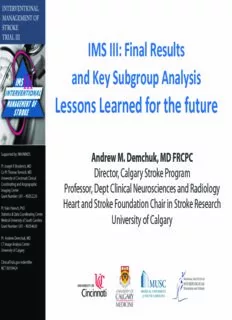
Andrew Demchuk, MD PDF
Preview Andrew Demchuk, MD
IMS III: Final Results and Key Subgroup Analysis Lessons Learned for the future Andrew M. Demchuk, MD FRCPC Director, Calgary Stroke Program Professor, Dept Clinical Neurosciences and Radiology Heart and Stroke Foundation Chair in Stroke Research University of Calgary Disclosure Slide • I have received honorarium from Covidien (supplier of SOLITAIRE FR stentriever). • IMS-‐3-‐ Exec commiDee, CT core lab PI • ESCAPE-‐ Neuro-‐PI • REVASCAT-‐ CT core lab co-‐PI • CLOTBUST-‐ER – CTA substudy PI • ARGIS-‐2 – CTA substudy core lab PI • ENCHANTED – InternaRonal Advisory CommiDee • I have no stocks or direct investments with pharmaceuRcal or device companies involved in stroke IMS III Support GRANT SUPPORT: NIH/NINDS Grant Numbers: UC U01NS052220 MUSC U01NS054630 and U01NS077304. FDA IND: #5785 Study Drug: Genentech,Inc. Microcatheters: EKOS Corp., Concentric Inc., Cordis Neurovascular, Inc. Key Design Features of IMS III • Combined IV t-‐PA (0.6 mg/kg) + endo vs IV tPA (0.9 mg/kg) • Planned 900 subjects • <3 hours LSN Rme window • 2 endo : 1 IV t-‐PA raRo randomizaRon • Age 18-‐82 years • NIHSS >/= 10, or NIHSS 8-‐9 with CTA evidence of ICA, M1 or basilar occlusion prior to iniRaRon of IV t-‐PA • Consent/randomizaRon within first 40-‐minutes IV t-‐PA infusion But must follow the instructions for use and could only choose one device. OK to also use endovascular t-PA via standard microcatheter if time remaining after use of device. April 2012: Preplanned 2/3rd DSMB IMS III – Crossed FuPlity Boundary • Upon recommendation of the DSMB, NINDS stopped enrollment because a predefined futility boundary was crossed, based upon the low conditional power, given an expected difference of 10% between the two groups and a sample size of 900. There were no significant safety concerns. • 656 subjects had been enrolled. No Significant Baseline Differences 69 vs 68 17 vs 16 122 vs 121 90-‐Day Modi,ied Rankin Scale Score Distribution All Subjects Differences between the two treatment groups across the enRre distribuRon of the mRS (p = 0.25, van Elterin test)
Description: